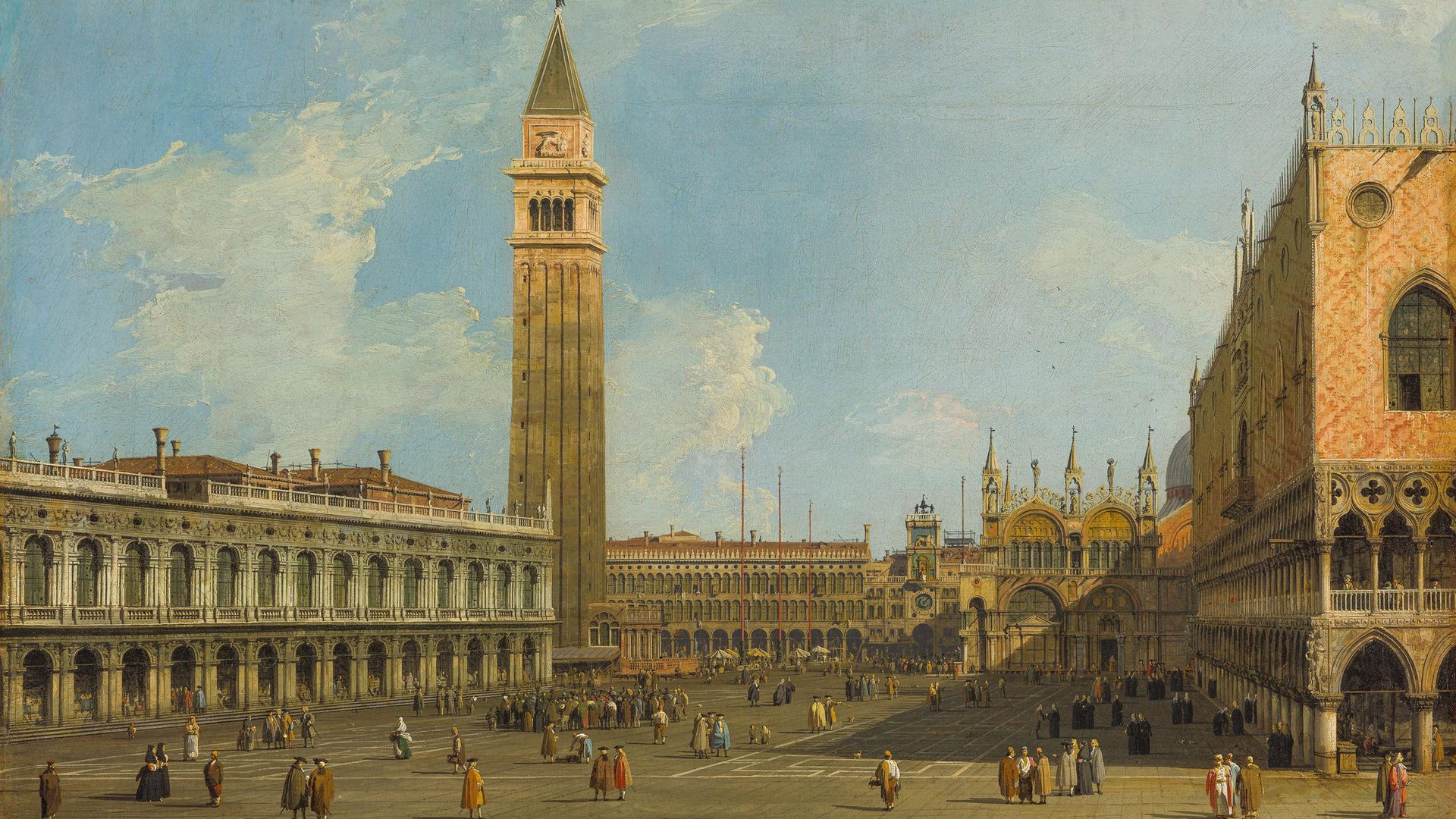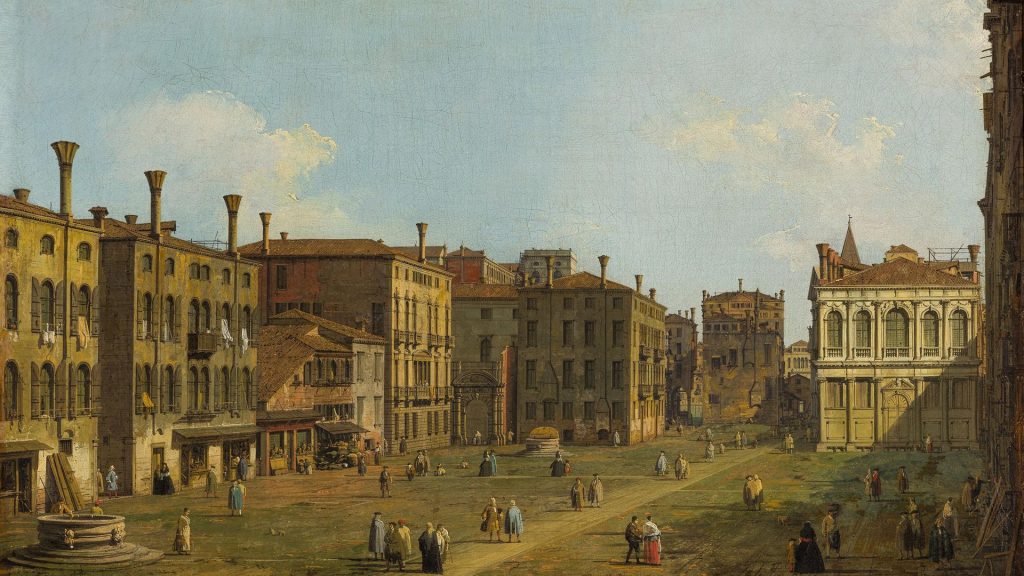
A new exhibition showcasing the works of Venetian artist Giovanni Antonio Canal, dubbed Canaletto, is set to open in Bath.
To begin when Covid restrictions permit, Canaletto: Painting Venice will run at the city’s Holburne Museum until September 5.
As Claudia Pritchard reports, such was Canaletto’s importance to our understanding and appreciation of the historic Italian city that his work is now helping assess its vulnerability to climate change.
Think of the Venetian artist Giovanni Antonio Canal, dubbed Canaletto, and glorious vistas of La Serenissima come to mind – the imposing Doge’s Palace and exotic St Mark’s Basilica fronting on to a grand and spacious square; graceful and boastful palaces, water lapping at their steps; the Rialto Bridge, rendezvous for Shylock, Antonio, and the rest of the world; even the stately London scenes from the painter’s 10 years in the capital. But few minds would conjure up, first and foremost, throngs of tiny, yellow-skinned characters.
So detailed are the paintings of Canaletto (1697-1768) – and as treasures of the English stately home so often hung further away than the eye can see – that he is pigeon-holed as a painter of cityscapes.

But, trained as a painter of theatre sets, he had a gift for personal observation and fly-on-the-wall drama, as demonstrated in a new exhibition opening soon in Bath, Canaletto: Painting Venice.
The loan to the Holburne Museum of a whole series of paintings, one of the largest private collections of Canaletto in the world, brings with it the chance to view 23 scenes of Venice in a new light.
All the paintings date from between 1731 and the end of that decade. In their home across the centuries at Woburn Abbey in Bedfordshire they have been displayed in the dining room in clusters or stacks of three.
Now, during renovations at the family seat of the Dukes of Bedford, the loaned collection can be viewed at eye level, revealing unexpected animation and vignettes in the broad sweeping scenes. And it is this close examination that reveals the artist’s penchant for golden skin, literally reflecting the exceptional light of a wealthy city built on water.
In the Scuola di San Rocca, a woman pretends to be hanging out the washing on one of the precarious and ingenious little roof terraces that perch atop closely packed dwellings, providing a little space to escape the throng – and the pong.
But in reality, this housework on the altana – roof terrace – is cover for some rewarding spying on neighbours and passers-by. In a view along the Grand Canal, all eyes are on the imposing Palazzo Balbi with its twin pinnacles.

But hard at work on a more modest building to the right of the picture are builders engaged in the vertiginous and backbreaking work of re-roofing, five precarious storeys above a watery fall.
Canaletto is perhaps at his most engaging when he homes in on crafts and trades, on artisans and water-borne merchants from many lands, their exotic headwear clue to the length of their journeys to this trading hub.
So successful was he at creating a vision of Venice, that today his pictures can look predictable. But it was his very ingenuity in constructing an edited and re-ordered distillation of the sometimes-awkward city that defined its tourist images ever after. Venice made Canaletto; but Canaletto created brand Venice.
The original tourists were the young men who, from the middle of the 17th century until the advent of mass tourism in the 19th century, were despatched through the mainland of Europe on the Grand Tour, with their moral guardian and tutor.
Among these privileged, long-term students – the cultural itinerary might last for years – was Lord John Russell, fourth Duke of Bedford, who, like many fellow travellers, fell for Canaletto.
In commissioning two dozen paintings from him, with the help of an intermediary, he was joining a well-to-do queue. It took eight years or so for the full set to be hung at Woburn Abbey, and other than occasional transfers to other ducal properties, the collection has never moved.

While the big set pieces are much on view, totems of brand Venice, the subject matter of other vedute – the term for large-scale paintings of vistas – is somewhat mystifying.
Campo Santo Stefano, for example, is one of the city’s less remarkable squares, inland from the bridge that crosses the Grand Canal to the Accademia on the Dorsoduro.
No one knows, admits exhibition curator Monserrat Pis Marcos, whether the choice of subjects was driven by the celebrity artist or his wealthy and influential patron, and why in this prestige set of pictures this unpromising scene was chosen.
Whoever was in the driving seat then, within 10 years or so it was the artist who had to move closer to his English market, when the War of the Austrian Succession put a stop to young Britons gallivanting on the mainland of Europe.
Canaletto was by no means locked to Venice, although the city made his name. In his set-designing days, working on Alessandro Scarlatti’s operas in Rome, he had been influenced by Giovanni Paolo Panini (1691-1765) who was documenting, if somewhat romantically, that city’s highlights.
Now, in May 1746, Canaletto set up in London, applying to London scenes and landmarks his honed formula of meticulous architectural detail and vigorous street life.
Then he ticked off the great country houses, among them Warwick and Alnwick Castles, and Syon House.

Often smoothing the path between artist and British patron was Joseph Smith, nicknamed ‘Consul’ Smith for his contacts and negotiating skills.
He built up his own large collection of Canalettos (later sold to George III), and acted as intermediary on many acquisitions, including Lord John Russell’s two dozen purchases.
On today’s equivalent of the Grand Tour, the modern traveller can book into an apartment in Smith’s home on the Grand Canal in the Cannaregio district, the Palazzo Mangilli Valmarana. Brokering art was a lucrative business.
As in all canal-side palaces, water laps at the steps of its grand entrance for arrivals by boat. And the paintings of Canaletto are proving an invaluable resource in urgent, climate-related research into rising watermarks.
Academic Dario Camuffo of the Italian International Research Council has made a study of today’s waterlines compared with those depicted in the artist’s painstaking pictures.
The algae is now visibly higher than ever before, staining the steps of the palace in the foreground and on the right in a view up the Grand Canal to the Rialto, Palazzo Erizzo Nani Mocenigo. Camuffo has even allowed for the sinking of the building under the additional weight of a floor added since Canaletto’s time.
With such calculations, it is possible to observe the rate at which the water is rising in Venice, work vital to its future. Shockingly, his research using several paintings and today’s readings proves that over three centuries the city has sunk by around 60cm. Canaletto, the darling of the well-heeled Georgian dilettante, has a new life, coming to the aid of a climate change-threatened world at large.
Canaletto: Painting Venice will be at the Holburne Museum, Bath until September 5.
Warning: Illegal string offset 'link_id' in /mnt/storage/stage/www/wp-includes/bookmark.php on line 357
Notice: Trying to get property 'link_id' of non-object in /mnt/storage/stage/www/wp-includes/bookmark.php on line 37







